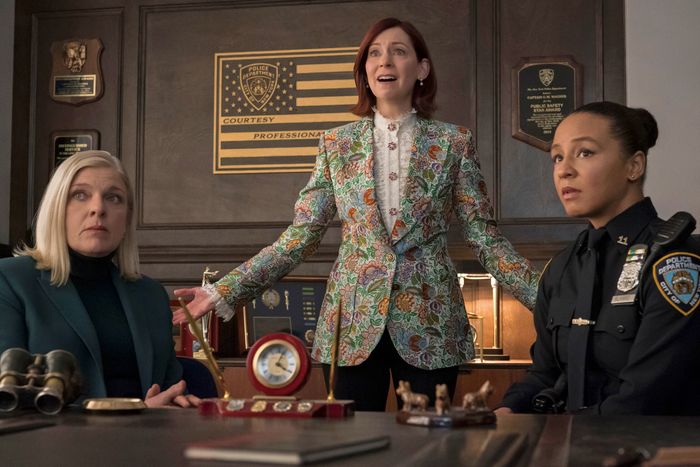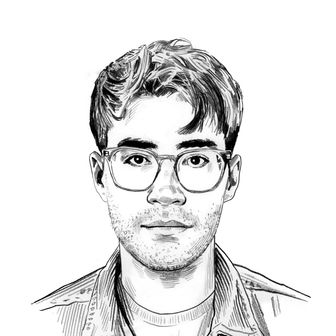
Picture this: It’s Halloween. Your doorbell rings. You grab the bowl of candy and open the door to hand out mini Snickers and Reese’s to trick-or-treaters. Standing before you is a gaggle of small children, all of them wearing red wigs and floral blouses with bright-pink blazers and holding no fewer than three tote bags each. “What are you guys dressed up as?” you ask. “We’re Elsbeth Tascioni from CBS’s Elsbeth,” the children shout in unison. That’s the future we’re rapidly heading toward.
Because Elsbeth Tascioni, the quirky lawyer who originated on The Good Wife and now helms a series of her own, has the kind of distinct signature look that spawns Halloween costumes for years to come. From the moment she first appears in the show’s pilot wearing a long pink coat and foam Statue of Liberty crown, it’s clear that a new fashion icon has arrived. As that touristy accessory suggests, she’s new to New York, taking on a job observing the NYPD’s investigations under a consent decree. In the process, the ultraobservant Elsbeth becomes a sleuth herself, circumventing the police to solve each week’s crime. But her wardrobe is far more Carrie Bradshaw than Columbo, featuring increasingly vibrant colors, elaborate patterns and prints, zany faux-fur hats, and dozens of massive tote bags in which she presumably keeps her hundreds of brooches.
By dressing Carrie Preston in these exciting looks, the show’s costume designer, Daniel Lawson (an alum of the Good universe), and the wardrobe team create an instantly recognizable aesthetic that reflects the character’s personality and puts the “serve” in “protect and serve.” When Elsbeth wakes up each morning, she opens her Crayola multipack of a closet and dresses not for the job she has but for the job she wants — if the job she wants is the lead in the best production of Joseph and the Amazing Technicolor Dreamcoat you’ve ever seen. It’s only a matter of time until a RuPaul’s Drag Race contestant portrays her for “Snatch Game.” Or better yet, Elsbeth Tascioni should co-chair the Met Gala. There’s no doubt in my mind that Harry Styles is bombarding his stylist with photos of Preston on set as we speak.
But the show’s fashions aren’t just visual — they have become more and more incorporated into the crimes Elsbeth solves as the season progresses. In one episode, she uses her bright-red convertible mittens to puppet how a murder could have played out. In another, she walks through the Hamptons with a scarf wrapped around her head like Little Edie while “Another Winter in a Summer Town” from Grey Gardens: The Musical plays. Perhaps there’s no better testament to the relationship between Elsbeth’s style sensibility and homicide than an outfit she wears while investigating a murder at a tennis match: a neon-pink visor, a green tennis skirt, and a sweater with “TENNIS” splashed across the front. Every crime scene may as well be a theme party, and Elsbeth always dresses to impress. So it feels only natural that the last case of the season in this week’s finale will take her to a fashion show — what better culmination of a season filled with runway-worthy looks?
Yes, the clothes lend themselves to her characterization as a deeply eccentric person, but they’re a great visual representation of the divide that exists between Elsbeth and the police department. Because despite her solving crimes week after week, it’s important to remember that Elsbeth is not a cop; she just happens to be better at the job. So having her dressed in vibrant colors and patterns to contrast with the boring blue uniforms and gray suits around her helps hammer home her outsider status. It’s also a great expository visual cue for casual or first-time viewers — it shouldn’t take long to realize that the woman dressed as Fran Fine might not be a badge-carrying detective.
Elsbeth’s style doesn’t just differentiate her from the police officers she works with; it also makes her stick out among her television contemporaries. Network crime procedurals don’t tend to have particularly exciting visual palettes, instead reflecting the dull uniform- and suit-filled world they’re portraying. That reflection extends to female investigators, who, in a tale as old as time, often have to dress more masculine to be taken seriously in these male-dominated work environments. The female leads on shows like Law & Order: SVU, The Equalizer, and 9-1-1 all have drastically different wardrobes from Elsbeth — usually either uniforms or black blazers and pants, maybe navy if they’re really feeling wild — making Preston’s explosion of fashionable feminine garb all the more refreshing.
Despite ignoring that stigma, Elsbeth isn’t immune to it: The detectives she works with often use her clothes to discredit her, disregarding “gut feelings from women who wear polka dots over the age of 15.” While a disadvantage among the force, her “unserious” fashion can work in her favor when investigating. Sure, conventional knowledge may suggest a sleuth would want to dress discreetly to slip under the radar, but Elsbeth achieves the same feat by doing the exact opposite. Criminals are prepared to keep their guard up around the police, and since Elsbeth’s appearance conveys that she is so clearly not the police, it’s easy for suspects to slip up. They underestimate her the same way the police department does and often meet their downfall because of it.
So heed this warning: If you have just murdered one of our finest theater and/or character actresses on a CBS procedural … beware of a redheaded woman in a floral pussy-bow blouse and colorful jacket. She will be your end.


